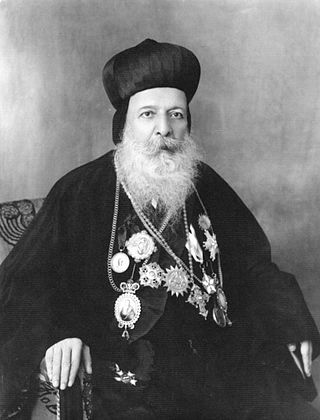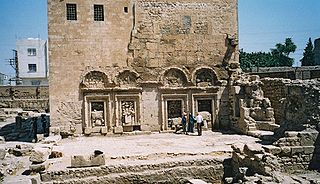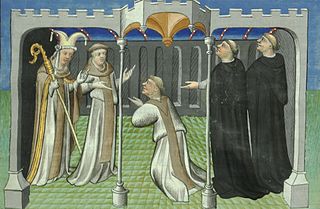See also
- Barsoum elements, a mathematical technique in finite element analysis
Barsauma (also spelled Barsawma, Barsawmo, Bar Sawma, Bar Sauma or Barsoum) is an Aramaic or Syriac name meaning "Son of the Fast" or "Son of Lent." It may refer to:
Barsauma, nicknamed Bar Sawma, "son of Lent" in Syriac, was Metropolitan of Nisibis in the 5th century, and a major figure in the history of the Church of the East. Under his leadership the church moved away from Roman loyalties and became increasingly aligned with the Nestorian movement.

Rabban Bar Ṣawma, also known as Rabban Ṣawma or Rabban Çauma, was a Uyghur or Ongud monk turned diplomat of the "Nestorian" Church of the East in China. He is known for embarking on a pilgrimage from Yuan China to Jerusalem with one of his students, Rabban Markos. Due to military unrest along the way, they never reached their destination, but instead spent many years in Ilkhanate-controlled Baghdad.

Dayro d-Mor Mattai is a Syriac Orthodox Church monastery on Mount Alfaf in northern Iraq, 20 kilometers northeast of the city of Mosul. It is recognized as one of the oldest Christian monasteries in existence.

Moran Mor Ignatius Jacob (Yaʿqub) III was the 121st Syriac Orthodox Patriarch of Antioch and head of the Syriac Orthodox Church 1957-1980. He was skilled in and knowledgeable in Syriac sacral music or Beth Gazo. He re-established the Maphrianate/Catholicate in the Jacobite Syrian Orthodox Church.

Ignatius Aphrem I Barsoum was the 120th Syriac Orthodox Patriarch of Antioch and head of the Syriac Orthodox Church from 1933 until his death in 1957. He was consecrated as a Metropolitan and as a Patriarch at a very hard time for the Syriac Orthodox church and its people and parishes and he worked very hard to re-establish the church initiations to where his people moved. He researched, wrote, translated, scriped, and published many scholarly works that included books on the saints, tradition, liturgy, music, and history of Syriac Orthodox Church.
John III of the Sedre was the Patriarch of Antioch and head of the Syriac Orthodox Church from 631 until his death in 648. He is commemorated as a saint by the Syriac Orthodox Church, and his feast day is 14 December.
Athanasius II Baldoyo, also known as Athanasius of Balad, and Athanasius of Nisibis, was the Patriarch of Antioch and head of the Syriac Orthodox Church from 684 until his death in 687.
Ignatius Behnam Hadloyo was the Patriarch of Antioch and head of the Syriac Orthodox Church from 1445 until his death in 1454.
Ignatius John XIV bar Shay Allah was the Patriarch of Antioch, and head of the Syriac Orthodox Church from 1483 until his death in 1493.

Polycarpus Augin Aydın, is the Metropolitan and Patriarchal Vicar for the Archdiocese of the Netherlands of the Syriac Orthodox Church. The Metropolitan Seat is located at St. Ephrem the Syrian Monastery in Glane/Losser, the Netherlands.
Dioceses of the Church of the East, 1318–1552 were metropolitan provinces and dioceses of the Church of the East, during the period from 1318 to 1552. They were far fewer in number than during the period of the Church's greatest expansion in the tenth century. Between 1318 and 1552, the geographical horizons of the Church of the East, which had once stretched from Egypt to China, narrowed drastically. By 1552, with the exception of a number of East Syriac communities in India, the ecclesiastical jurisdiction of the Church of the East was confined to its original heartland in northern Mesopotamia.

The Metropolitanate of Nisibis was an East Syriac metropolitan province of the Church of the East, between the fifth and seventeenth centuries. The ecclesiastical province of Nisibis had a number of suffragan dioceses at different periods in its history, including Arzun, Beth Rahimaï, Beth Qardu, Beth Zabdaï, Qube d’Arzun, Balad, Shigar (Sinjar), Armenia, Beth Tabyathe and the Kartawaye, Harran and Callinicus (Raqqa), Maiperqat, Reshʿaïna, Qarta and Adarma, Qaimar and Hesna d'Kifa. Aoustan d'Arzun and Beth Moksaye were also suffragan dioceses in the fifth century.
Acacius was Catholicos of Seleucia-Ctesiphon and Patriarch of the Church of the East from 485 to 496. His tenure was marked by internal christological and ecclesiological disputes. He struggled to prevent the Church of the East from aligning itself with the 'Nestorian' doctrine espoused by the metropolitan Barsauma of Nisibis. He is included in the traditional list of patriarchs of the Church of the East.

Yahballaha III, known in earlier years as Rabban Marcos or Yahballaha V, was Patriarch of the East from 1281 to 1317. As patriarch, Yahballaha headed the Church of the East during the severe persecutions under the reign of khans Ghazan and his successor Öljaitü. He acknowledged the primacy of the Pope and tried to form a church union, which was rejected by the Nestorian bishops of the Church of the East.

Moran Mor Ignatius Aphrem II is a Syrian-American Christian prelate who is serving as the Patriarch of the Syriac Orthodox Church since 29 May 2014.
Marutha of Tikrit was the Grand Metropolitan of the East and head of the Syriac Orthodox Church of the East from 628 or 629 until his death in 649. He is commemorated as a saint by the Syriac Orthodox Church.
Dionysius II was the Patriarch of Antioch and head of the Syriac Orthodox Church from 896/897 until his death in 908/909.
Athanasius VI bar Khamoro was the Patriarch of Antioch, and head of the Syriac Orthodox Church from 1091 until his death in 1129.

The Syriac Orthodox Monastery of Saint Mark is a Syriac Orthodox monastery and church in the Old City of Jerusalem. According to a 6th-century inscription that was found at the Monastery of St Mark's in Jerusalem during a restoration in 1940, the church is supposed to have been built on the ancient site of the house of Mary, mother of St. Mark the Evangelist and the place of the Last Supper of Christ with His disciples. However, other Christians believe that the Last Supper was held at the nearby Cenacle on Mount Zion.
Athanasius VII bar Qatra was the Patriarch of Antioch, and head of the Syriac Orthodox Church from 1139 until his death in 1166.